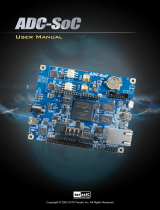
IO60-M410/General Operation
v1.0 www.winsystems.com Page 3
Analog Input (ADC)
• Uses Linear Technology LTC1859 Analog-to-Digital Converter (16-bit)
• Provides eight single-ended inputs or four differential inputs: 0 V to 5 V, 0 V to
10 V, ±5 V, ±10 V
• Jumper installable 250 resistors can be used to transform a 4 mA to 20 mA cur-
rent input to a 1 V to 5 V signal.
Analog Output (DAC)
• Uses Analog Devices, Inc. AD5755 (16-bit)
• Provides four single-ended voltage outputs: 0 V to 5 V, 0 V to 10 V, ±5 V, ±10 V, or
4 mA to 20 mA current output (current to voltage conversion)
• Unipolar and bipolar operation
• Single-ended or differential operation
General Purpose Input-Output (GPIO)
• 24 lines provided within the Lattice Semiconductor Corp., MachXO2™ FPGA (field-
programmable gate array)
• Level converters provide support up to 30 VDC
• Each line programmable for input, output, or event sense
• I/O > 5V require external supply voltage to pin 49 of J4.
• Current: 12 mA sink, 5 mA source (dependent on the user provided voltage)
• Programmable interrupts
5. General Operation
The design of the IO60-M410 provides 24 bits of general purpose I/O organized in three
8-bit I/O ports (0, 1, and 2), an ADC converter, and a DAC converter. The ports are
accessed through two Serial Peripheral Interface (SPI) commands.
The SPI interface is implemented through the MACH XO2 SPI-slave EFB (Embedded
Function Block) interface. Each bit of each port is implemented as a bi-directional tri-
state driver. Each bit of each port can also be configured and enabled to detect both
rising and/or falling edge events and generate a system interrupt.
A read only interrupt status register is provided to simplify determination of the
interrupt source when multiple simultaneous interrupts are enabled. The circuit is
controlled by two simple SPI commands sent from an external SPI master device.
The SPI Master communicates with the PLD through the SPI bus comprised of four
signals (SLCK, MISO, MOSI, and SCSN). The SCSN signal must first be driven low prior
to a valid SPI operation. After SCSN is asserted, the embedded chip select decoder will
decode the first 8 bits of data and generate a chip select for either the on-chip SPI
SLAVE GPIO logic block, the external DAC, or the external ADC. Subsequent operands
and data are then exchanged on the SPI bus.
























